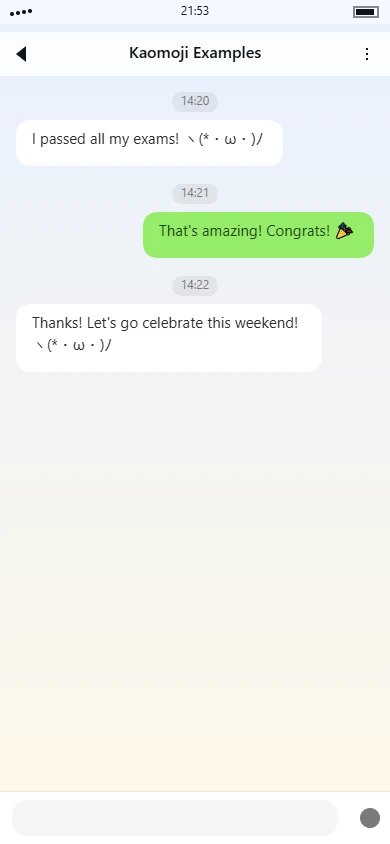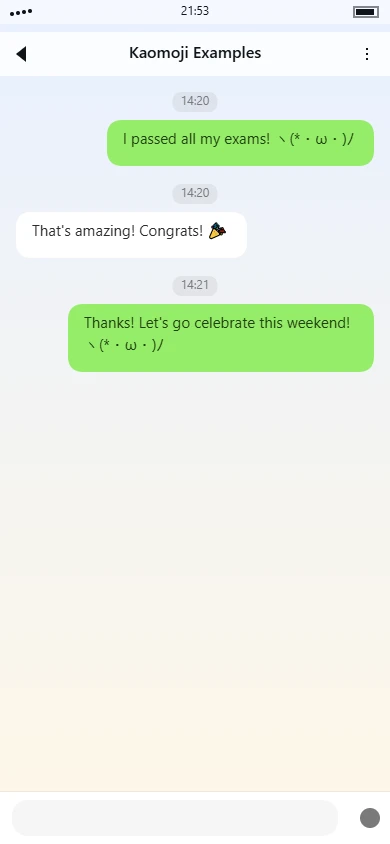(〃^▽^〃) kaomoji meaning | usage tips

Overview
The kaomoji (〃^▽^〃) presents a stylized facial expression that conveys a sense of cheerful embarrassment or bashful happiness. Its symmetrical structure and carefully chosen characters create a balanced visual representation of someone feeling both delighted and slightly self-conscious.
Visual Structure Explanation
This kaomoji uses a combination of Japanese quotation marks and katakana characters to form a complete face. The outer parentheses (〃) serve as the facial outline, creating a rounded shape that encloses the expression. Inside this frame, the upward-pointing caret symbols (^) function as eyes, positioned at the upper corners to suggest a lifted, happy gaze. The central katakana character (▽) forms the mouth area, with its triangular shape pointing downward to create a gentle smile. The overall composition maintains visual symmetry, with each element carefully spaced to create a cohesive facial expression.
The character selection contributes to the kaomoji's soft appearance. The use of full-width characters throughout gives the expression a slightly larger, more rounded quality compared to standard ASCII characters. The spacing between elements is consistent, allowing each component to remain distinct while working together as a unified face. The upward angle of the eye characters combined with the downward-pointing mouth creates a balanced visual tension that suggests both happiness and mild embarrassment.
Symbol Breakdown
- Outer parentheses (〃): These are Japanese-style quotation marks that serve as the face's contour. Their curved shape creates a soft boundary around the expression, suggesting a rounded face or cheeks.
- Eye characters (^): The caret symbols, when used in full-width form, resemble upward-curving eyes that convey happiness or excitement. Their upward angle suggests a cheerful, optimistic expression.
- Mouth character (▽): This katakana character creates a triangular shape that points downward, forming a gentle smile. The downward orientation suggests a slightly bashful or contained happiness rather than an open-mouthed grin.
- Full-width formatting: All characters use full-width spacing, which gives the kaomoji a more substantial, deliberate appearance compared to half-width alternatives.
Emotion & Aesthetic Analysis
This kaomoji expresses a specific type of happiness that includes elements of shyness or self-consciousness. The combination of upward-facing eyes and a downward-pointing mouth creates a nuanced emotional state - someone who is genuinely happy but also feeling a bit bashful about their happiness. This differs from more straightforward happy kaomoji like (^_^) which expresses simple joy without the additional layer of self-awareness.
The aesthetic leans toward cute or kawaii styles common in Japanese digital communication. The rounded shapes and balanced proportions create a friendly, approachable appearance. The expression suggests someone who is pleased but trying to contain their excitement, making it suitable for situations where one wants to express happiness while maintaining a degree of modesty or restraint.
In practical use, this kaomoji often appears in contexts where someone is sharing good news but wants to do so humbly, or when expressing appreciation for a compliment. It can also convey a sense of "happy embarrassment" when receiving praise or attention. The expression sits somewhere between pure joy and mild shyness, making it versatile for various positive but slightly self-conscious situations.
Tag categories
Use tags to quickly understand this kaomoji.
Usage guide
Understanding (〃^▽^〃) in Digital Communication
The kaomoji (〃^▽^〃) represents one of the most versatile and widely recognized expressions in Japanese-inspired digital communication. Characterized by its raised hands and cheerful facial expression, this emoticon conveys a sense of innocent happiness, playful excitement, or gentle contentment. Unlike more intense happy faces, (〃^▽^〃) carries a distinctly cute and somewhat bashful quality—it's the digital equivalent of someone clapping their hands together in delight while maintaining a sweet, slightly shy demeanor. You'll commonly encounter this kaomoji in casual online spaces where users want to express genuine warmth without coming across as overly enthusiastic or aggressive. Its balanced emotional tone makes it suitable for everything from celebrating small victories to showing appreciation for others' achievements.
Common Use Cases
- Expressing genuine happiness when a friend shares good news in a group chat
- Reacting to cute animal photos or heartwarming content on social media
- Showing appreciation when someone compliments your work or appearance
- Celebrating small personal achievements like completing a difficult task
- Responding to invitations or plans you're excited about
- Adding warmth to thank-you messages in casual online conversations
- Reacting to funny memes or jokes that make you genuinely smile
- Expressing gentle excitement about upcoming events or releases
- Softening requests or apologies to maintain a friendly tone
- Showing support for friends' creative projects or accomplishments
- Reacting to romantic gestures or sweet messages from partners
- Expressing contentment with simple pleasures like good food or weather
Example Conversations
-
Friend sharing good news Person A: "I finally got accepted into the graduate program!" Person B: "That's amazing! So proud of you (〃^▽^〃)"
-
Reacting to cute content Person A: "Just adopted this little kitten from the shelter" [sends photo of kitten] Person B: "Oh my goodness, look at those eyes! (〃^▽^〃) So precious!"
-
Casual planning between friends Person A: "The new café downtown has that matcha latte you've been wanting to try" Person B: "Really? We should go this weekend! (〃^▽^〃)"
-
Workplace appreciation (casual teams) Colleague A: "Thanks for helping me debug that code yesterday" Colleague B: "No problem at all! Happy I could help (〃^▽^〃)"
-
Online gaming community Player A: "Just got the rare drop we've been farming for weeks!" Player B: "Nice! Our patience finally paid off (〃^▽^〃)"
-
Family group chat Family Member: "Made your favorite cookies for when you visit this weekend" You: "Can't wait! You're the best (〃^▽^〃)"
Important Considerations
While (〃^▽^〃) is incredibly versatile in casual settings, its distinctly cute and playful nature means it's not suitable for all contexts. Understanding when and where to use this expression will help you communicate more effectively.
-
Avoid formal contexts: This kaomoji is inappropriate for professional emails, official communications, or serious discussions where a more neutral tone is expected. The playful nature could undermine your professionalism in business settings.
-
Cultural interpretation differences: While widely understood in global online communities, some users from cultures less familiar with Japanese emoticons might interpret the raised hands as praying or religious symbolism rather than excitement.
-
Tone matching: Be mindful that (〃^▽^〃) conveys gentle happiness rather than extreme excitement. In situations requiring stronger emotional expression (like major celebrations), you might want to use more intense emoticons or combine it with exclamation points for emphasis.
-
Platform appropriateness: This kaomoji works particularly well on platforms like Discord, Twitter, casual messaging apps, and gaming communities. On more professional networks like LinkedIn or in formal work chat channels, it's better to stick with standard emoji or plain text.
-
Relationship context: The sweet, slightly bashful quality of (〃^▽^〃) makes it perfect for friends and close acquaintances but might come across as overly familiar or even flirtatious when used with strangers or in new professional relationships.
-
Generational understanding: Younger internet users typically understand kaomoji expressions immediately, while older generations might find them confusing. Consider your audience's familiarity with digital communication trends before using.
When used thoughtfully, (〃^▽^〃) can add warmth and personality to your digital conversations, helping to bridge the emotional gap that often exists in text-based communication. Its balanced emotional tone makes it one of the most reliably pleasant expressions in the kaomoji repertoire, suitable for countless everyday situations where you want to convey genuine, gentle happiness.
Usage examples
Real conversation samples that feature this kaomoji.

Example 1

Example 2
Related kaomoji
You might also enjoy these kaomoji.